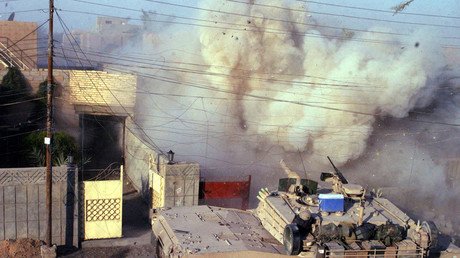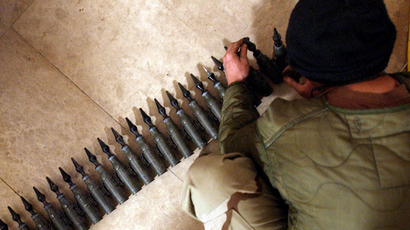Fallujah 12 years on: Americans ‘last people to consider’ generations crippled by depleted uranium
November 7 marks 12 years since the second battle of Fallujah was launched by US, Iraqi, and British troops in 2004. Fallujah residents still suffer from the consequences today, with many accusing Washington of using deadly depleted uranium weapons.
According to some reports, chemical weapons may have been used during the battle, also known as Operation Al Fajr and Operation Phantom Fury, which is considered the bloodiest of the Iraq War.
A number of scientists have linked an increased rate of health problems in the Fallujah population to the US-led attacks, including birth defects and cancer.
Which specific substances may have been used is still unknown. Only the use of white phosphorus has been officially confirmed by the US.
Although over a decade has passed, Fallujah residents are still suffering from the consequences of the battle.
“The most interesting thing is that nothing has got any better,” Professor Christopher Busby, scientific secretary of the European Committee on Radiation Risks, told RT.
“The level of congenital malformation, the level of ill health in the children as they are born is not improving, which means that whatever it was that happened long ago is still in the genetic make-up of the people who live there,” he said.
A number of scientists and doctors have attributed serious health issues to the US military’s use of depleted uranium (DU) anti-tank weapons.
“We know it was exposure to uranium because we measured the uranium in our study. We spent a lot of money looking at the uranium levels at the hair of the parents of the children with congenital malformations. So, there’s no doubt about it being uranium,” Professor Busby said.
Washington is doing its best to downplay the effects of DU, he added.
“It’s becoming clear now that uranium has very serious genetic qualities that are still not considered by authorities. The last people to consider it will be the Americans, the American military, and the people who are most dependent upon it. They don’t want to get rid of this ‘magical weapons.’ And they are fighting tooth and nail, including scientifically, to try and show that there isn’t this serious problem that there quite obviously is.
“The people who control or try to control the understanding of the health effects of uranium are the people who are associated with the military and governments who need to show that they didn’t do anything wrong and can continue to use this stuff. So, yes, there is a cover-up, no question about it. And it’s at a very high level. It will have to stop because evidence that’s emerging in periodic literature is absolutely massive. It doesn’t only come from Iraq and from exposure to depleted uranium. It comes from exposure to uranium from uranium workers in France and from uranium miners in Namibia, and nuclear test veterans who were exposed to uranium,” Busby said.
“Because of such a politicized factor, the US government has not been supportive of scientific research on these issues and have not been willing to take any responsibility,” Ross Caputi, a US marine veteran, who was in the second battle of Fallujah in November of 2004, told RT.
“A lot of weapons that we used in Fallujah in 2004 are being used presently in Mosul, in Iraq, and also in Syria,” he added.
Washington “broke its own rules firing depleted uranium in Iraq,” Targets of Opportunity, an organization calling for a ban on the use of depleted uranium, said in a report released last month. The group’s analysis of recently declassified military data shows that the “US military ignored its own guidelines for the use of depleted uranium ammunition in the 2003 Iraq War, firing the controversial weapons at unarmored targets, buildings in populated areas and troops. It has also tripled the number of sites known to be contaminated in Iraq to more than 1,000; even as fears grow that the US has used depleted uranium in Syria.”
At least 440,000 kilograms of DU were used in Iraq, some ending up as DU dust, and some as corroding penetrators leaving a still unknown number of sites with contaminated vehicles, buildings, and soils, according to a Dutch report.
“It’s actually very difficult to decontaminate an area that’s been affected by depleted uranium, because it spreads so uniformly across the area and in the form of these very fine particles. So, it’s not a case of going somewhere and finding something that’s radioactive and removing it. You can do that, but the thing that are causing the problem is the inhalation of these dusts. And once the dust is created, it goes all over the place. The damage that’s been done to the DNA, you can’t clean that up, it’s already there. The continuing level of congenital malformations and cancer presumably is an indicator of the fact that the genome of these people has been affected, and that’s like a sort of trans-generational curse that will go on for a very long time, for generations,” Professor Busby said.
Many eyebrows were raised when the World Health Organization (WHO) said in its report that the “rates for spontaneous abortion, stillbirths and congenital birth defects found in the study are consistent with or even lower than international estimates. The study provides no clear evidence to suggest an unusually high rate of congenital birth defects in Iraq.”
Professor Busby, who has long studied what has been described as an epidemic of cancers and birth defects in Iraq, told RT that the main problem with that study is, first and foremost, that it wasn’t carried out at a hospital.
“The study by the WHO, which incidentally was a disgraceful study, just looked at children whose parents said they had congenital malformations. On that basis, in fact, they found they had a lower level of congenital malformations than the expected number throughout the world, which should have led them to the idea that maybe the study wasn’t working. That study was a very, very bad study, and should never have been published,” he added.
Meanwhile, samples taken from children living in Iraqi cities bombed during the US-led campaign also show lead poisoning, which, according to environmental toxicologist Mozhgan Savabieasfahani, is a result of pollution caused by American military bases and the war.
“We still do see the impact of those bombardments,” Savabieasfahani told RT.














